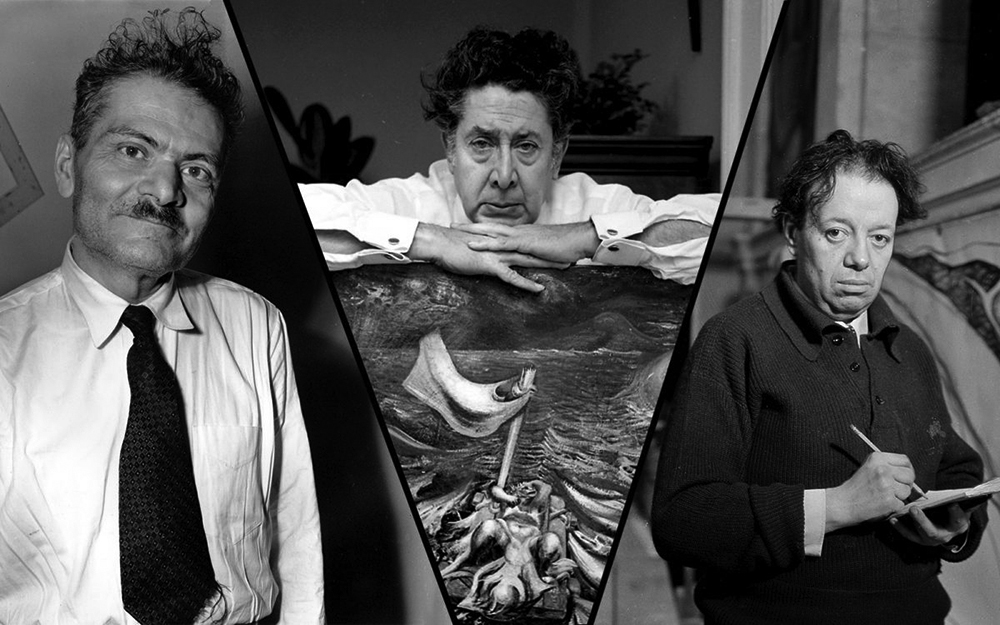A muralism, a very Mexican artistic movement
Shared/by Mexico Unknown
Muralism was an artistic movement that was born in Mexico in the 1920s. The idea was to bring the people closer to the history of Mexico and at the same time generate social awareness about the situation of inequality that was inherited from the Porfiriato. The main Mexican muralists were: David Alfaro Siqueiros, José Clemente Orozco and Diego Rivera. Learn more about these characters and about their artistic training.
3 Mexican muralists
David Alfaro Siqueiros
He was born on December 29, 1896. His place of origin is disputed between Chihuahua and Mexico City. His parents were Teresa Siqueiros and the lawyer Cipriano Alfaro.
Siqueiros studied at the National Preparatory School. At the same time and at night, he went to the Academy of San Carlos. Here he participated in a student strike that demanded the dismissal of the director and the change in the teaching method. As a result, the outdoor academy at Santa Anita emerged.
It was the time of the Mexican Revolution and Siqueiros, along with other colleagues, decided to join Carranza’s Constitutional Army against Victoriano Huerta. Siqueiros traveled the length and breadth of the country. At that moment he realized the social inequalities and injustices that the majority of the population suffered.
Once he won Carranza, Siqueiros moved to Mexico City. Here he met Diego Rivera with whom he later traveled through Italy. There they studied Renaissance art together.
In 1922, Siqueiros returned to Mexico City to work as a muralist. In this site he received the great support of José Vasconcelos. The two, along with Rivera and Orozco, shared the ideal of educating the masses through public art.
Due to his inclination for Marxist ideals and his constant criticism -written and pictographic- of the government, Siqueiros was imprisoned on several occasions. In fact, he remained in Lecumberri for four years, accused of “social dissolution.” However, not even while in prison did he stop painting. In addition, he was also accused of participating in an attack against León Trostky for which he had to go into exile in Chile.
On January 6, 1974, David Alfaro Siqueiros died, one of the Mexican muralists who marked the 20th century.
Representative works
- Burial of a worker (1923). It is in the hole of the Colegio Chico.
- New Democracy (1944-1945). It is located in the Palace of Fine Arts.
- From Porfirio Diaz to the Revolution (1957-1966). It is in the Chapultepec Castle.
Diego Rivera
Diego María de la Concepción Juan Nepomuceno Estanislao de la Rivera y Barrientos Acosta y Rodríguez, better known as Diego Rivera, was born on December 8, 1886 in the City of Guanajuato. His parents were María Barrientos and Diego Rivera Acosta.
Diego Rivera’s artistic life formally began in 1896. In that year he entered the Academia de San Carlos. There he met the great landscape designer José María Velasco. Nine years later, he received a scholarship from the then Secretary of Education, Justo Sierra.
Fortune smiled on Rivera due to his talent. The latter led him to travel through Europe and other places. He had the opportunity to interact with intellectuals such as Alfonso Reyes, Ramón María del Valle-Inclán and Pablo Picasso.
Years later, Rivera returned to Mexico and participated in the campaigns proposed by José Vasconcelos. At that time he met José Clemente Orozco, David Alfaro Siqueiros, Rufino Tamayo and the French artist Jean Charlot.
In 1922, in addition to marrying Guadalupe Marín, he joined the Mexican Communist Party. After divorcing Marín, he married the painter Frida Kahlo in 1929. In that same year, he was expelled from the Communist Party.
Unlike Siqueiros, Rivera sympathized with Trotsky, which is why he gave the Russian politician political asylum in 1937. Kahlo and Rivera received him at the Casa Azul.
Rivera died on November 24, 1957 in Mexico City (Coyoacán).
Representative work
- Frescoes (1922) in the Ministry of Public Education.
- The Man at a Crossroads (1934). This work is in the Palace of Fine Arts.
- Dream of a Sunday Afternoon in the Alameda Central (1947). This mural is located in the Diego Rivera Mural Museum.
Mural The Man at a Crossroads
Jose Clemente Orozco
Considered the “Mexican Goya” -due to the warm climate of his works-. Orozco was born in 1883 in Zapotlán, Jalisco. His father was Ireneo Orozco and his mother was María Rosa Flores.
While still an infant, Orozco met José Guadalupe Posada. This generated a great interest in painting. For family reasons, the Orozcos had to move to Guadalajara and later to Mexico City.
In 1906, our muralist entered the San Carlos Academy of Fine Arts to consolidate his talent in drawing. A short time later, he began a degree in agricultural engineering. However, that did not fill his spirit, which is why he decided to dedicate himself completely to painting in 1909.
Two years later, he worked as an illustrator and cartoonist. He dedicated himself to making satires on the Mexican Revolution to earn economic income. Around that time, Orozco painted The House of Tears. In this, a strong social criticism was made of the environment in which prostitutes were forced to live.
In 1922 he joined Diego Rivera, David Alfaro Siqueiros and other artists. Together they gave rise to the Mexican muralist movement. The intention was to abandon the European influence and be inspired by pre-Columbian and popular cultures. In addition, in their works they manifested their political protests and sought to bring the people closer with their art.
Orozco died in 1949 in Mexico City and was buried in the Rotunda of Illustrious Men.
representative works
- Omniscience (1925). It exists in the House of Tiles.
- The Trench (1926). This work is located in the Government Palace of Guadalajara.
- The Man on Fire (1938-1939). This mural is in the Vault of the Hospicio Cabañas.



